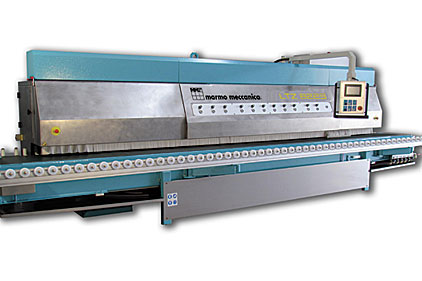Offering a flat edge at 90 degrees with rounding of the two corners is a style of processing that is becoming more and more popular, particularly in certain markets. Typically, this work is executed with “torus polishers,” both with belt and stationary bench, although at a slower rate compared to flat edge with chamfering or completely rounded edges, Marmo Meccanica reports.

The LCR can perform this profile as fast as polishing machines for flat edge can do, even on “difficult” materials, such as agglomerates.
Briefly described, the LCR structure is composed of:
• One ingoing calibrating/drip-cutting unit, adjustable both crosswise and lengthwise adjustable, for calibration or drip-cutting
• Seven polishing mandrels to polish, face and brush the edge, the first of which is equipped with a mechanical stop for the diamond tool
• Two upper and lower 45-degree chamfering mandrels for pre-chamfering diamond tools, equipped with a mechanical stop, which makes it possible to execute pencil-round edges
• Two groups of three mandrels each, counter-oscillating (mechanical stop on the first one of each group), for pencil-round chamfers (maximum 4-cm thickness) and 45-degree flat chamfers (maximum 6-cm thickness).
Furthermore, as a standard feature, the machine is equipped with the electronic running of the pneumatic mandrels (PLC) for partial processing, distinct advances and delays for each mandrel and for polishing the edge of non-rectangular slabs. This is achieved using a user-friendly touch-screen control panel.
On request, it is also possible to apply micro-oscillation for polishing on flat edges over 45 mm thick, and to customize it by adding extra polishing mandrels (up to nine) or functional groups.







